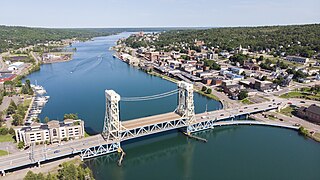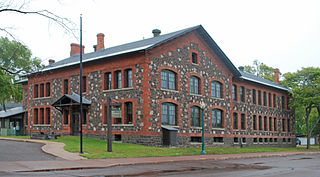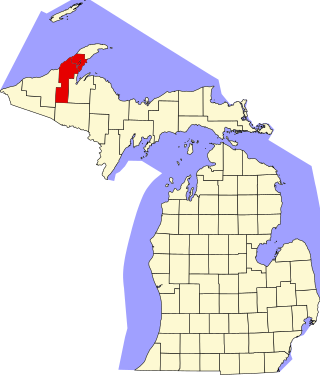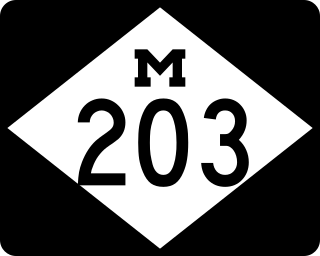
Houghton is the largest city and county seat of Houghton County in the U.S. state of Michigan. Located on the Keweenaw Peninsula, Houghton is the largest city in the Copper Country region. It is the fifth-largest city in the Upper Peninsula, with a population of 8,386 at the 2020 census. Houghton is the principal city of the Houghton micropolitan area, which includes all of Houghton and Keweenaw counties. Houghton lies upon the Keweenaw Waterway, a partly natural, partly artificial waterway connecting at both ends to Lake Superior. Across the waterway from Houghton lies the city of Hancock.

Copper Island is a local name given to the northern part of the Keweenaw Peninsula, separated from the rest of the Keweenaw Peninsula by Portage Lake and the Keweenaw Waterway.

Hancock is a city in the Upper Peninsula of the U.S. state of Michigan. The population of Hancock was 4,501 at the 2020 census. The city is located within Houghton County, and is situated upon the Keweenaw Waterway, a channel of Lake Superior that cuts across the Keweenaw Peninsula. Hancock is located across the Keweenaw Waterway from the city of Houghton, and is connected to that city by the Portage Lake Lift Bridge. The city is located within Michigan's Copper Country region.

Houghton County is a county in the Upper Peninsula in the U.S. state of Michigan. As of the 2020 census, the population was 37,361. The county seat and largest city is Houghton. Both the county and the city were named for Michigan State geologist and Detroit Mayor Douglass Houghton.

M-26 is a 96.355-mile-long (155.068 km) state trunkline highway in the U.S. state of Michigan, running from two miles (3.2 km) east of Rockland to its junction with US Highway 41 (US 41) in Copper Harbor. It generally runs southwest-to-northeast in the western half or Michigan's Upper Peninsula. The northernmost segment, which closely parallels the shore of Lake Superior on the west side of the Keweenaw Peninsula, is highly scenic.

Dee Stadium, also called The Dee, is an ice hockey arena in Houghton, Michigan, that replaced, and is located on the same site as, the Amphidrome. It is regarded as the birthplace of professional hockey, and is the seventh oldest indoor ice rink in the world.

The Keweenaw Waterway is a partly natural, partly artificial waterway which cuts across the Keweenaw Peninsula of Michigan; it separates Copper Island from the mainland. Parts of the waterway are variously known as the Keweenaw Waterway, Portage Canal, Portage Lake Canal, Portage River, Lily Pond, Torch Lake, and Portage Lake. The waterway connects to Lake Superior at its north and south entries, with sections known as Portage Lake and Torch Lake in between. The primary tributary to Portage Lake is the Sturgeon River.

The Quincy Mine is an extensive set of copper mines located near Hancock, Michigan. The mine was owned by the Quincy Mining Company and operated between 1846 and 1945, although some activities continued through the 1970s. The Quincy Mine was known as "Old Reliable," as the Quincy Mine Company paid a dividend to investors every year from 1868 through 1920. The Quincy Mining Company Historic District is a United States National Historic Landmark District; other Quincy Mine properties nearby, including the Quincy Mining Company Stamp Mills, the Quincy Dredge Number Two, and the Quincy Smelter are also historically significant.

Keweenaw National Historical Park is a unit of the U.S. National Park Service. Established in 1992, the park celebrates the life and history of the Keweenaw Peninsula in the Upper Peninsula of the U.S. state of Michigan. It is a federal-local cooperative park made up of two primary units, the Calumet Unit and the Quincy Unit, and almost two dozen cooperating "Heritage Sites" located on federal, state, and privately owned land in and around the Keweenaw Peninsula. The National Park Service owns approximately 1,700 acres (690 ha) in the Calumet and Quincy Units. Units are located in Baraga, Houghton, Keweenaw, and Ontonagon counties.

Mont Ripley is a ski hill located in Franklin Township, Houghton County, in Michigan's Upper Peninsula. The site is just outside the cities of Hancock and Houghton. It is owned by Michigan Technological University. It was founded in the early 1900s by Fred Pabst Jr.. With the addition of snow making in 2000, the season has been extended from late November to late March or early April.

This is a list of the National Register of Historic Places listings in Houghton County, Michigan.

The International Professional Hockey League (IPHL) was the first fully professional ice hockey league, operating from 1904 to 1907. It was formed by Jack "Doc" Gibson, a dentist who played hockey throughout Ontario before settling in Houghton, Michigan. The IPHL was a five team circuit which included Pittsburgh, Pennsylvania, Sault Ste. Marie, Ontario, Sault Ste. Marie, Michigan, Calumet, Michigan and Houghton. The IPHL was instrumental in changing the nature of top-level senior men's ice hockey from amateur to professional.

M-203 is a north–south state trunkline highway in the Upper Peninsula of the US state of Michigan. It connects McLain State Park with US 41 on each end in Hancock and Calumet. The trunkline has existed since commissioning in 1933 except a period of time when it was temporarily decommissioned.

In Michigan, copper mining became an important industry in the 19th and early 20th centuries. Its rise marked the start of copper mining as a major industry in the United States.

The Quincy Mining Company Stamp Mills Historic District is a historic stamp mill located on M-26 near Torch Lake, just east of Mason in Osceola Township. It was listed on the National Register of Historic Places in 2007.

The Quincy Smelter, also known as the Quincy Smelting Works, is a former copper smelter located on the north side of the Keweenaw Waterway in Ripley, Michigan. It is a contributing property of the Quincy Mining Company Historic District, a National Historic Landmark District. The smelter was built in 1898 by the Quincy Mining Company, operating from 1898 to 1931 and again from 1948 to 1971. The smelter was part of a Superfund site from 1986 to 2013.
UP Health System - Portage is a hospital and associated healthcare system based in the Keweenaw Peninsula of Michigan. The healthcare system has several clinics stretching as far north as Lake Linden, Michigan and as far south as offices in L'Anse, Michigan and Ontonagon, Michigan. The system's main building is a 36-bed hospital in Hancock, Michigan. The Portage Health Hospital employs more than 800 people, and is the second largest employer in Houghton County, behind Michigan Technological University. The hospital is one of two in the state of Michigan to be recognized as a Level III trauma center by the American College of Surgeons.
The Houghton Giants were a minor league baseball team based in Houghton, Michigan. In 1906 and 1907, the "Giants" played as members of the Northern-Copper Country League. The Giants were preceded in minor league play by the "Houghton" team that played as members of the independent Upper Peninsula League in 1890 and 1891, winning the 1890 league championship. Houghton first hosted home minor league games at the East Houghton Grounds and then at Ripley Sands Park.

















